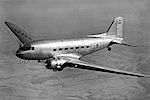By TOM HUNTINGTON [American Heritage] – On April 26, 1944, the 72-year-old Orville Wright posed for a photograph at the controls of a Lockheed Constellation, a triple-tailed, four-engined behemoth that could reach 340 miles per hour and had a ceiling of 24,000 feet. Only four decades earlier, Wright had taken the Flyer, a fragile creation of wire, wood, and muslin, on the first controlled, powered, and human flight in a heavier-than-air vehicle. He noted that his first wobbling flight of 120 feet had been shorter than the Constellation’s wingspan.
In the first four decades of human flight, inventors, innovators, and entrepreneurs spurred a dizzying evolution in flying machines. The first steps, though, were somewhat tentative. Following their initial success, the Wright brothers returned to their home in Dayton, Ohio, and refined the design. Not until 1908 did the airplane really take the world by storm, when Wilbur made a series of wildly-acclaimed demonstration flights in Europe and Orville amazed crowds by flying just outside Washington, D.C. Wilbur’s mission was triumphant, but Orville’s ended in tragedy. On September 17, 1908, he crashed, badly injuring himself and killing his passenger, Lt. Thomas E. Selfridge, who belonged to a rival team of airplane designers.
Continued at American Heritage | For our own coverage of early flight: The Art of Flying | More Chronicle & Notices.






















Post a Comment